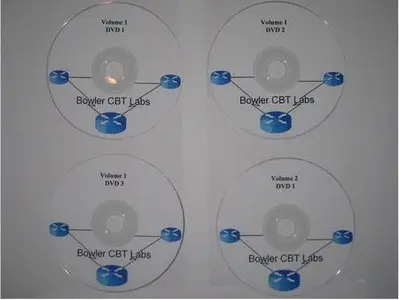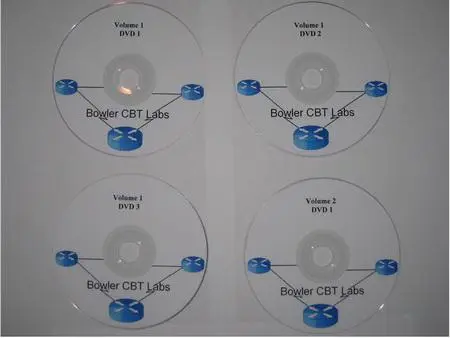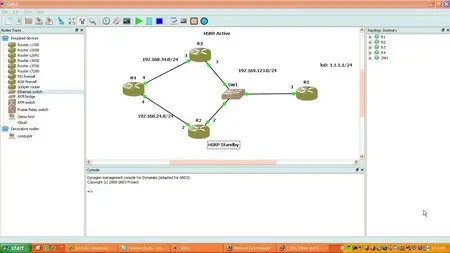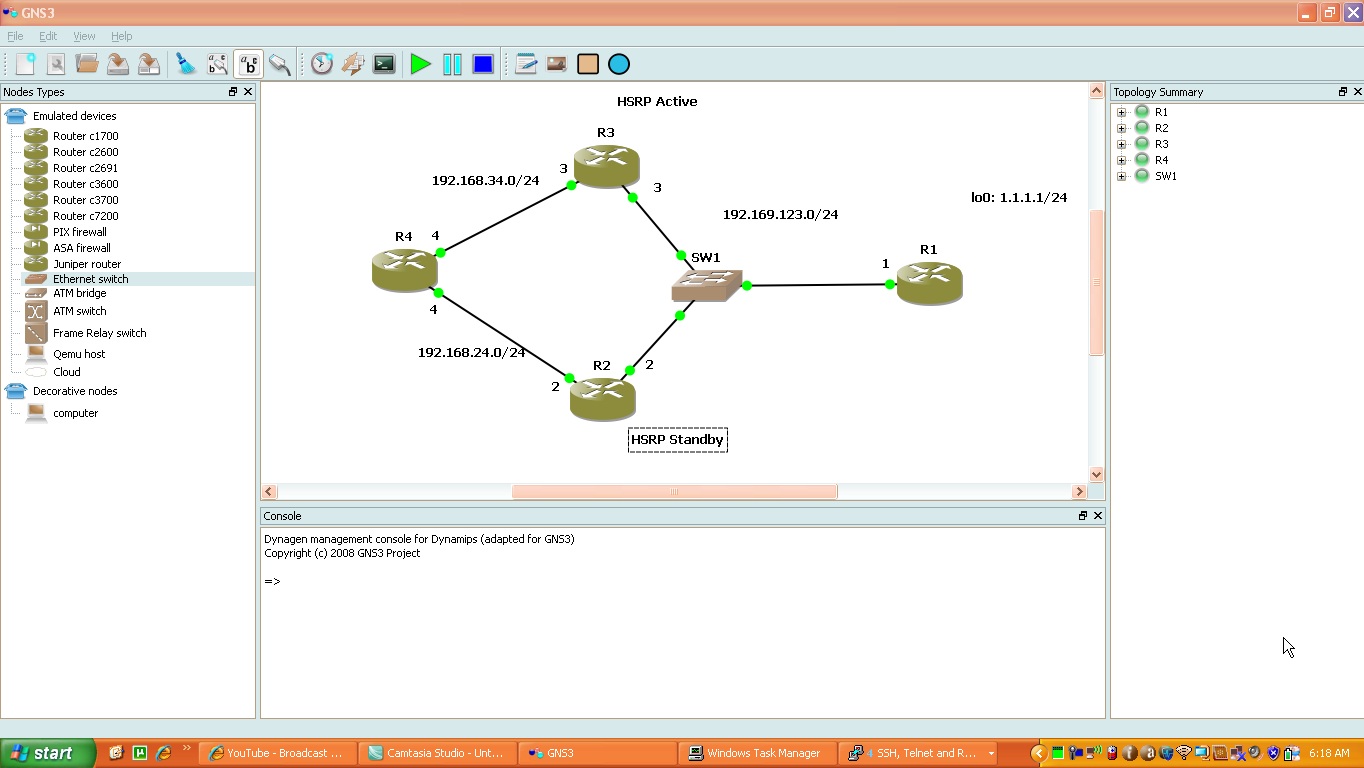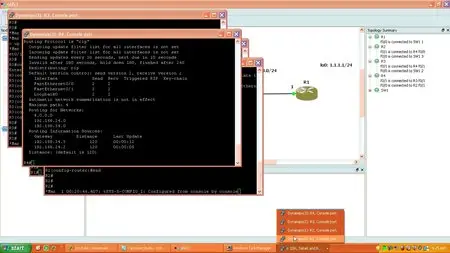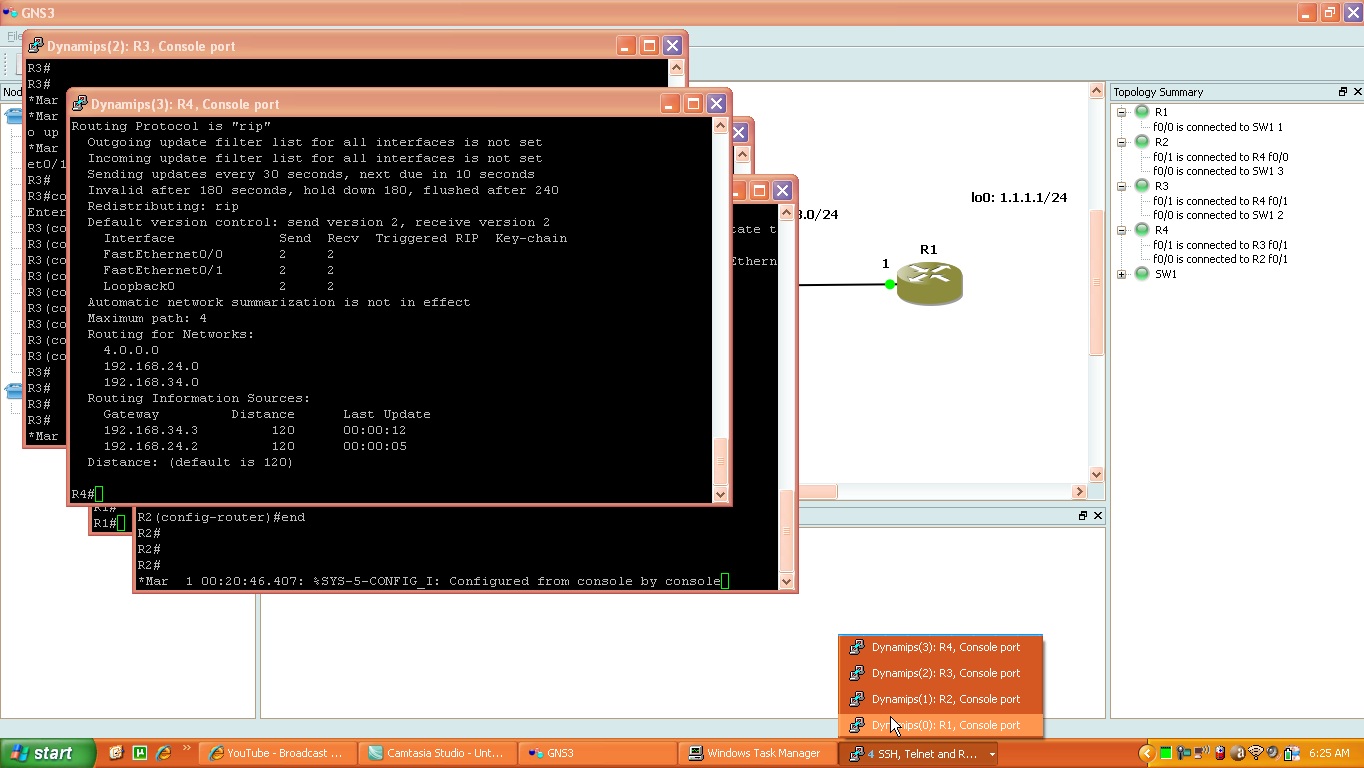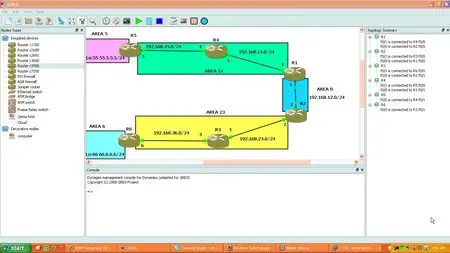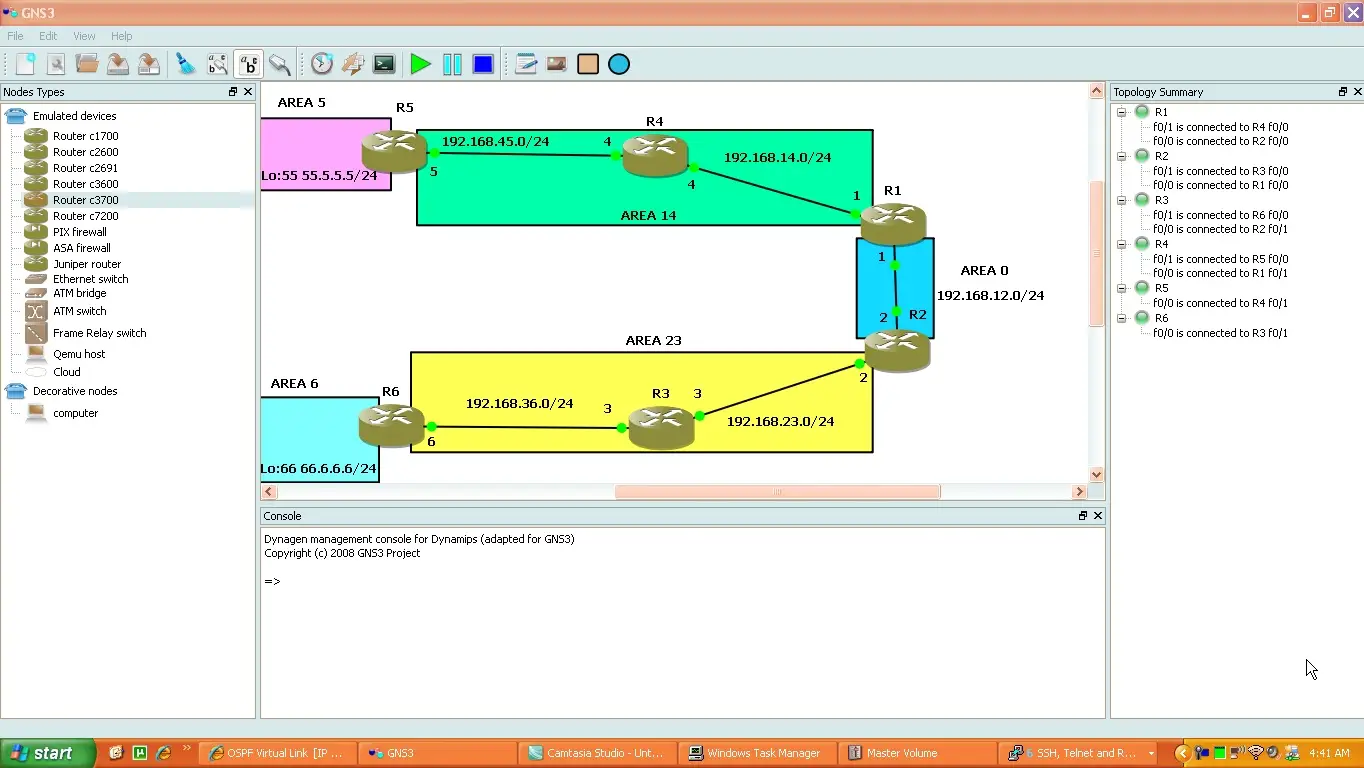Steve Bowler - GNS3 Bowler Cisco CBT (4 DVDs)
DVD (4 DVD's)| AVI | MPEG-4 @ 1.5 Mbit/s | 1278x720 | MP3 Stereo @ 128 Kbit/s 44 KHz | 14 GB
Genre: Cisco Networking | Language: English
DVD (4 DVD's)| AVI | MPEG-4 @ 1.5 Mbit/s | 1278x720 | MP3 Stereo @ 128 Kbit/s 44 KHz | 14 GB
Genre: Cisco Networking | Language: English
These labs are based strictly around configuring routers and switches using the Cisco Command Line Interface (CLI) and are accompanied by easy to follow network topologies designed by myself. There are no “theory” based videos. Studies have proven that “hands on” training is the best and most efficient way to learn and that is strictly what I offer. So sit back, relax, start up your routers and switches and prepare to join me and prepare yourself for hours upon hours of “hands on” training.
Enhanced Interior Gateway Routing Protocol (EIGRP)
*Configure/Explain EIGRP and use show/debug commands for verification
*EIGRP Basics
*EIGRP Network command
*EIGRP MD5 Authentication
*Explain how EIGRP calculates the composite metric
*EIGRP Summarization
*EIGRP Leak-maps
*EIGRP default route
*Virtual Template Interfaces
Border Gateway Protocol (BGP)
*Configure/Explain BGP concepts listed below and use show/debug commands for verification
*BGP MD5 Authentication
*BGP TTL Security
*BGP Outbound Route Filtering (ORF) between 2 routers
*Configure/Explain BGP and use show/debug commands for verification
*External BGP (EBGP)
*Internal BGP (IBGP)
*BGP Authentication
*BGP Route Reflector’s
*BGP AS_Path attribute
*BGP Local Preference attribute
*BGP Default Route
*BGP Route Aggregation
*BGP Route Dampening
*BGP Suppress-Maps
*BGP Unsuppress-Maps
*EBGP Multihop
*BGP Update Source Loopback
*BGP Weight Attribute
*BGP Multi-Exit Discriminator (MED) Attribute
*BGP Community Attribute
*BGP Confederations
*IP Prefix-Lists for BGP
Frame Relay
*Configure/Explain Frame Relay concepts listed below and use show/debug commands for verification
*Frame Relay End to End Keepalives (EEK)
*Point to Point Protocol (PPP) Multilink over Frame Relay
*Explain and show how to setup Virtual Template interfaces and how they are used with PPP over Frame Relay.
*Frame Relay Static configuration
*Frame Relay Point to Point configuration
*Frame Relay point-to-multipoint configuration
*Frame Relay switch in GNS3
IPv6
*Configure/Explain IPv6 concepts listed below and use show/debug commands for verification
*Setting up Frame Relay Static maps using IPv6
*Routing Information Protocol Next Generation (RIPng)
*Configure RIPng on 3 routers on an Ethernet network and explain how RIPng works in comparison to RIPv2
*Enhanced Interior Gateway Protocol (EIGRP) IPv6
*Configure EIGRP IPv6 on 3 different routers in an Ethernet network and show the differences between EIGRP IPv6 and EIGRP IPv4
*Open Shortest Path First Version 3 (OSPFv3)
*Configure OSPFv3 on 3 different routers over frame relay
*Explain how OSPFv3 is different than OSPF IPv4
*Explain the link-local IPv6 addresses and how they are used to provide reachability over frame relay networks using IPv6 dynamic routing protocols
*Border Gateway Protocol for IPv6, Mulitprotocol BGP (MBGP)
*Configure BGP IPv6 between 2 different routers and explain how BGP IPv6 works in comparison to BGP IPv4
*Configure IPV6 on Fast Ethernet and Loopback Interfaces
*Configure IPV6 Static Routing
*IPV6 address auto-configuration
Routing Information Protocol (RIPv2)
*Configure/Explain RIPv2 concepts listed below and use show/debug commands for verification
*Setup RIPv2 Offset Lists and explain how they are used to manipulate RIPv2 metrics and their filtering capabilities
*Setup RIPv2 Summarization
*RIPV2 on 6 routers
*RIPV2 plain text and md5 authentication
*Detailed look at rip hop count metric
Open Shortest Path First (OSPF)
* Configure/Explain OSPF concepts listed below and use show/debug commands for verification
* OSPF over Frame Relay using the network types of Non-Broadcast and Broadcast.
* Explain the different characteristics of Non-Broadcast and Broadcast network types in OSPF and how to configure and verify them.
* How to optimize your OSPF over Frame Relay using Broadcast and Non-Broadcast network types
* Configure All OSPF Area types including, Stub Area, Totally-Stub Area, Not So Stubby Area (NSSA) and Totally NSSA.
* Explain all the different OSPF area types and how they are used to filter Link State Advertisements on within different OSPF Areas
* Configure Redistribution of RIPv2 routes into the OSPF domain
* OSPF Basics
* OSPF in Five different Areas
* OSPF simple and MD5 authentication
* OSPF Summarization (Internal)
* Explain the basics of OSPF
* OSPF Virtual links
* OSPF Virtual link alternative (GRE Tunnel)
Switching Labs
*802.1Q Tunnelling
*Configure/Explain how to setup an 802.1q Tunnel and show the characteristics of a L2VPN.
* Show how you can use an 802.1q Tunnel to create a Layer 2 VPN to tunnel CDP information between to Switches that are not directly connected.
*Switchport Security
*Configure/Explain how to use Switchport Security and show the characteristics of Switchport Security
*Explain how Switchport Security can be used to secure your switches from outside attacks.
*Explain the 3 different modes of Switchport security and also show you advanced Switchport security features to help ease the administration of switchports.
*Configure/Explain Etherchannels and use show commands for verification
*Configure a layer 2 Etherchannel
*Configure a layer 3 Etherchannel
*How to verify Etherchannel connectivity
*Dynamic Trunking Protocol (DTP)
*Configure/Explain DTP and use show commands for verification
*Vlan Trunking Protocol (VTP)
*Configure/Explain VTP and use show commands for verification
*Explain the different modes of VTP
*VTP Authentication
*VTP Pruning
*Vlan Trunking from a Switch to a Router
*Configure/Explain “router-on-a-stick” and use show commands for verification
*Configure/Explain VLAN’s and use show commands for verification
IP Multicast
* Configure/Explain Multicast concepts listed below and use show/debug commands for verification
* Auto RP between 4 routers
* Explain the concept of a mapping agent within AutoRP.
* Explain how to announce multicast groups on a RP into the Auto RP domain and how the Mapping Agent will discover, advertise and Map to the groups to the specific RP’s.
*Configure IP Protocol Independent Multicast Dense Mode (PIM-DM)
*Configure IP Protocol Independent Multicast Sparse Mode (PIM-SM)
Access Control Lists
* Configure/Explain the Zone Based Firewall concepts listed below and use show/debug commands for verification
* Setup a Zone Based Firewall (ZBF) and show how they work with the MQC configuration set.
* Explain in detail how filtering takes place within ZBF’s
* Explain the different Zone types
* Explain the concept of a Zone Pair
* Explain how you apply the policy map to the Zone pairs
* Explain how to put interfaces into different Zones
* Standard Access Control List (ACL)
* Virtual Terminal Line (VTY) Filtering
* Time Based Access Control List (TBACL)
* Explain/Verify how TBACLs work
* IP route-cache flow to monitor network traffic on the router
Quality of Service (QoS)
* Configure/Explain the QoS concepts listed below and use show/debug commands for verification
* Explain in detail how to setup and use the Modular Quality of Service Command Line Interface (MQC) configuration set
* Show how to use Class-maps, Policy-maps and apply the policy map inbound/outbound on an interface.
* IP Network Based Application Recognition (NBAR)
* Explain in detail how to implement NBAR and how it can be used proactively to discover Applications and Protocols that are running on or through a specific interface
* Explain Packet Description Language Module (PDLM) and how it can be used in NBAR
* Explain in detail the “Match Protocol” Class map statement and how it is related to NBAR
* Legacy Frame Relay Traffic Shaping (FRTS)
* Explain in detail how to setup and use Legacy FRTS on 3 different routers using the concept of a map-class to apply under the specific Data Link Connection Identifiers (DLCI’s)
* Explore some of the main features of Legacy FRTS and explain them such as map-class, CIR, Bc, Be, Tc, BECN, Adaptive shaping, MINCIR.
Point to Point Protocol (PPP)
*Configure/Explain PPP Multilink on 2 routers across multiple Serial point-to-point connections.
*Explain the concept of bundling multiple interfaces together to form one logical interface.
*PPP Authentication over Point to Point Serial Link
*PPP CHAP Authentication
*PPP PAP Authentication
Multi Protocol Label Switching (MPLS)
*Configure/Explain MPLS and use show/debug commands for verification
*MPLS Unicast IP Forwarding
MPLS VPN’s
*Configure/Explain MPLS VPN’s and use show/debug commands for verification
*Virtual Routing and Forwarding (VRF)
*Multi-Protocol BGP (VPNV4)
*Mutual Redistribution between PE and CE nodes running RIPv2
*Explain BGP AS-Path Attribute in MPLS VPN
*BGP allow-as in
*BGP as-override
On-Demand Routing (ODR)
*Configure/Explain ODR and use show/debug commands for verification
*Explain Cisco Discovery Protocol (CDP) and its use with ODR
Floating Static Route
*Configure/Explain floating static route and use show/debug commands for verification
IP Services
*Configure/Explain Dynamic Host Configuration Protocol (DHCP) on a router and use show/debug commands for verification
*Microsoft loopback adapter on your computer to act as a DHCP Client for the DHCP Server in GNS3
*Configure/Explain Network Time Protocol (NTP) on a router and use show/debug commands for verification
*Basic NTP for both Broadcast and Non-broadcast Networks
Policy Based Routing (PBR)
*Configure/Explain PBR and use show/debug commands for verification
*Policy Based Routing using a Route-map
Generic Routing Encapsulation (GRE)
*Configure/Explain GRE Tunnel and use show/debug commands for verification
*GRE Tunnel
*EIGRP Across GRE Tunnel
*Explain GRE Tunnel Basics
Hot Standy Router Protocol (HSRP)
*Configure/Explain HSRP and use show/debug commands for verification
*HSRP Preemption
*HSRP traffic flow
Connecting Real Switches to GNS3/Dynamips
*Connect a real 3550 to GNS3
*Verify connectivity between the router in GNS3 and the Real 3550
*Give you specifications on my GNS3/Dynamips Server
Redistribution
*Perform Mutual Redistribution between RIPv2 and OSPF
*Use a route-map to tag routes
*Explain RIP and OSPF Metrics
*Verify that redistribution is being performed properly using show commands
GNS3
*Configure/Explain how to use GNS3 and set it up to use.


